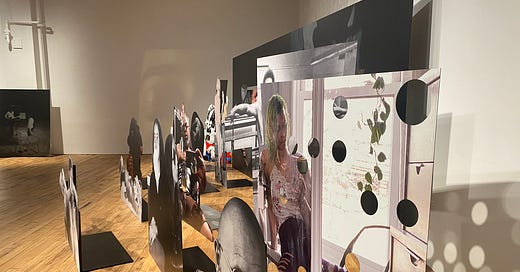Is Arthur Jafa unassailable? Jafa’s Love is the Message, The Message is Death (2016) has been on a near-constant repeat in museums and galleries since its debut. Clip after clip, the video streams images of Black Americans from news, film, and social media sources; there’s no sense of criticism or condemnation from within the editing itself, but the ensuing flow of raw data is so torrential, making it hard to imagine otherwise. Just look at the comments left on a bootleg version uploaded to YouTube to realize that Jafa’s data does not give the impression of impartiality.
Jafa’s been in so many exhibitions since Love… that, again, this gives off the impression that he’s unassailable. Two solo exhibitions of his work, BLACK POWER TOOL AND DIE TRYNIG at 52 Walker and ***** at Gladstone Gallery, just closed in New York this past spring. This time the praise hasn’t been unanimous, as I came to realize through looking at Greg Allen’s blog this past week.
Allen points out that Alex Greenberger at ARTnews found the images Jafa compiled too “random.” That’s an odd point to make, one seemingly contradictory to Greenberger’s own, earlier statement in the essay about how, with Love…, it’s not about the individual images so much as the “friction that results when they rub up against one another, shorn of their initial context.” Yes, I’ll buy that, but with the addition that this is the type of friction that makes people feel actual pain—again, see the YouTube comments for all the people who’ve cried in front of this video. If it’s friction, it begins like a rug burn and then scabs over.
At this point, what can I add to this list of reviews of BLACK POWER TOOL AND DIE TRYNIG? I’m not sure how many self-identified women, queer people, POC, or, maybe, people who are known for writing about race and gender were hired to review this show. Danielle Jackson’s review for Cultured was so good, and Zoë Hopkins for ArtReview, too—but it doesn’t seem like too many others. Could this lack of not just racial diversity but, say, sexual diversity, explain the seeming desert of writing on all the possible inferences to “glory holes”? Even with an image of Michel Foucault laughing in Large Array II, I don’t know how Discipline & Punishment hasn’t been mentioned yet (to my knowledge). Pope.L wrote and made work through his conception of “Hole Theory,” so that could make for an interesting comparison, too. Anyways, it’s not like Jafa hasn’t been making work about holes over the last decade-plus—2 Holes Are Better Than 1 (2015) is a particularly gruesome example—so discussions about holes might add some necessary confusion and eccentricity back into a practice that mainstream publications want to make more readily understandable.
Along with the zipped lips about holes, I have a pretty simple response to the seeming randomness of the images: the title of the Cady Noland-esque stand-up figures, Large Array II seems to be absolutely essential to understanding the arrangement of images. In machine learning, an array is a “mutable sequence” that can be further manipulated, sliced, or otherwise worked upon. All elements in an array have equivalent properties. In an array, like many other sequences, individual elements can be accessed, but it’s really how they work together as a data set that their full value can be gathered. In fact, an array might look like gibberish—just a series of numbers—until someone does something with it. In fact, they might look random, until someone applies a Machine Learning 101 algorithm to the set. (I just wrapped up taking a machine-learning course as part of my research into AI, so of course I’m thinking about arrays.)
So, is Arthur Jafa unassailable? Of course not. But it seems like there’s an issue with figuring out how to write about his work outside of terms people are already familiar with.
Now, look: I’ve written individual sentences and full essays that were regrettable, too. As much as it sucks to bring up, talking about what we do and don’t want from art criticism is a way to get to better ways of writing. At least, I hope so.
Other shows I liked but haven’t written about yet:
Florencia Escudero, Phygitalia, Rachel Uffner: An exhibition that asks what would happen if someone got stuck inside a bad Tumblr, then spit out to become a life-size vessel that swiffered up all the debris. That’s not the only question asked by this work, but I’m glad to see sculpture made weird, with screen culture made material through a combination of handmade, goopy, textured surfaces. The non-living are given life through the sculptural body.
Kat Chamberlain, Viceroy, Parent Company: Viceroy is a cinematic beauty: mysterious, luscious, and unsettling. But the real standout was hiring a professional psychonalyst to describe your work as part of the exhibition. I should have more to say, but I really need to put out this newsletter this morning.
Again, sorry for all the typos and words I may regret saying later. Thanks for reading.



